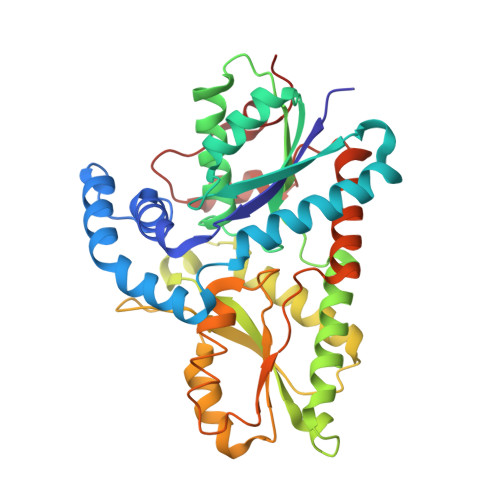Mitochondrial contact site and cristae organizing system (MICOS) machinery supports heme biosynthesis by enabling optimal performance of ferrochelatase.
Dietz, J.V., Willoughby, M.M., Piel III, R.B., Ross, T.A., Bohovych, I., Addis, H.G., Fox, J.L., Lanzilotta, W.N., Dailey, H.A., Wohlschlegel, J.A., Reddi, A.R., Medlock, A.E., Khalimonchuk, O.(2021) Redox Biol 46: 102125-102125
- PubMed: 34517185
- DOI: https://doi.org/10.1016/j.redox.2021.102125
- Primary Citation of Related Structures:
7L78 - PubMed Abstract:
Heme is an essential cofactor required for a plethora of cellular processes in eukaryotes. In metazoans the heme biosynthetic pathway is typically partitioned between the cytosol and mitochondria, with the first and final steps taking place in the mitochondrion. The pathway has been extensively studied and its biosynthetic enzymes structurally characterized to varying extents. Nevertheless, understanding of the regulation of heme synthesis and factors that influence this process in metazoans remains incomplete. Therefore, we investigated the molecular organization as well as the physical and genetic interactions of the terminal pathway enzyme, ferrochelatase (Hem15), in the yeast Saccharomyces cerevisiae. Biochemical and genetic analyses revealed dynamic association of Hem15 with Mic60, a core component of the mitochondrial contact site and cristae organizing system (MICOS). Loss of MICOS negatively impacts Hem15 activity, affects the size of the Hem15 high-mass complex, and results in accumulation of reactive and potentially toxic tetrapyrrole precursors that may cause oxidative damage. Restoring intermembrane connectivity in MICOS-deficient cells mitigates these cytotoxic effects. These data provide new insights into how heme biosynthetic machinery is organized and regulated, linking mitochondrial architecture-organizing factors to heme homeostasis.
Organizational Affiliation:
Department of Biochemistry, University of Nebraska, Lincoln, NE, 68588, USA.















